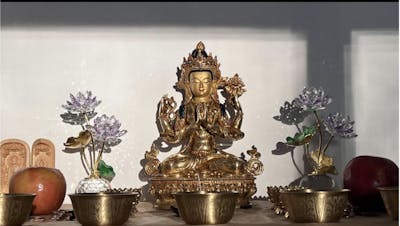-
-
-
Nepalese Vajrapani Statue | Handcrafted Wrathful FigurineRegular price $1,800.00
$2,000.00Sale price -
-
-
-
Oxidized Copper Vajrapani Statue | Handmade Tibetan SculptureRegular price $1,251.00
$1,390.00Sale price -
Sacred Vajrapani Statue | Tibetan Buddha for FearlessnessRegular price $900.00
$1,000.00Sale price -
Powerful Vajrapani Statue | Traditional Buddhist Icon of StrengthRegular price $1,710.00
$1,900.00Sale price -
-
Vajrapani Statue
Nidhiratna's Vajrapani Statue: The Protector of the Dharma and the Embodiment of Power
Nidhiratna's Vajrapani statue is a striking embodiment of strength, protection, and wisdom in the world of Tibetan Buddhism. Known as the protector of the Buddha and the Dharma, Vajrapani is a fierce, wrathful deity who uses his immense power to safeguard the teachings of the Buddha and the spiritual practitioners who follow them. As one of the earliest and most significant Bodhisattvas in Mahayana Buddhism, Vajrapani’s role as a protector and defender against negative forces makes him a highly revered figure in Buddhist iconography. Crafted with intricate detail and deep symbolism, this statue captures Vajrapani’s formidable nature and divine energy, making it a powerful tool for spiritual protection and transformation.
Made of copper and beautifully gold-gilded, the statue reflects the radiant and indestructible qualities of Vajrapani. The gold finish emphasizes his divine and protective nature, adding to his aura of strength and power. Each curve, each detail in his facial features, robes, and ornamentation is carefully sculpted by skilled Nepalese artisans, channeling the essence of Vajrapani’s might and compassionate energy. The artistry behind this statue speaks to the deep knowledge and tradition passed down through generations, resulting in a work that not only serves as a physical manifestation of Vajrapani but also as a spiritual guide for practitioners.
Vajrapani is often depicted with a fierce expression and an intense posture, symbolizing his role as a defender of the Dharma and a destroyer of negative forces. His powerful stance represents his readiness to protect all beings from harm, and his wrathful expression is not one of anger but of unwavering compassion, as he seeks to eliminate the obstacles and hindrances that prevent sentient beings from attaining enlightenment. In his right hand, Vajrapani typically holds a vajra (a diamond scepter), the symbol of indestructible wisdom and power, which he uses to cut through ignorance and delusion. In his left hand, he often holds a gesture of protection or a symbolic object, such as a lotus, representing purity and spiritual growth.
Vajrapani’s iconography is distinct and highly symbolic. His muscular body, adorned with jewelry, a crown, and a garland of skulls, conveys his strength and authority, as well as his connection to the cycle of life and death. His wild, unkempt hair, often depicted flowing behind him in an energetic swirl, symbolizes the untamed power of his spiritual energy. His eyes, wide and piercing, convey his vigilance and determination to protect the teachings of the Buddha from all negative influences.
His wrathful expression is also a representation of his compassion, as his fierce energy is channeled to remove obstacles and purify the minds of sentient beings. While his form may appear intimidating, Vajrapani’s essence is one of deep protection and loving-kindness, directed toward the well-being of all beings.
Vajrapani is often associated with the practice of Vajrayana Buddhism, where he serves as a spiritual protector who clears the way for practitioners to attain higher states of consciousness. As the guardian of the Buddha’s teachings, Vajrapani’s strength is invoked to remove obstacles to spiritual development and to safeguard practitioners from harm. His power is seen as essential in overcoming the negative influences of ignorance, desire, and hatred, thus clearing the path to enlightenment.
Vajrapani’s Mantra:
The mantra of Vajrapani is "Om Vajrapani Hum", a powerful invocation that activates his protective qualities and calls upon his strength to eliminate obstacles and negative energies. The mantra is often recited for protection, healing, and the removal of hindrances on the path to enlightenment. The meaning of the mantra is both simple and profound:
- Om: The universal sound representing the source of all existence.
- Vajra: The indestructible diamond scepter, symbolizes the strength of wisdom and the power to break through ignorance.
- Pani: Refers to the hand, symbolizing the power and protective energy that Vajrapani offers to practitioners.
- Hum: The transformative sound that activates the energy of the mantra, purifying negativity and empowering the practitioner.
Each syllable of the mantra carries a deep spiritual significance, invoking Vajrapani’s indomitable strength and protective energy to overcome the obstacles and challenges faced by practitioners on their journey to spiritual realization.
Vajrapani: The Guardian of the Dharma
Vajrapani is a dynamic and essential figure in Buddhist practice. As the protector of the Buddha and the Dharma, his energy is harnessed to remove obstacles, protect the teachings of the Buddha, and ensure the safety and progress of practitioners. His fierce and powerful form serves as a reminder of the strength needed to confront and overcome the obstacles that arise on the spiritual path. Through Vajrapani’s protection, practitioners can face their challenges with courage, confidence, and the assurance that they are guided by a powerful protector who ensures the success of their spiritual journey.
This statue of Vajrapani, with its imposing presence and energetic design, serves as not only a beautiful work of art but a potent spiritual tool, inviting the practitioner to invoke the power of this protector to clear the way to enlightenment. Whether displayed in a temple, meditation space, or home, this statue represents the unwavering strength and protection that Vajrapani offers to all who seek to follow the path of the Buddha.


























































